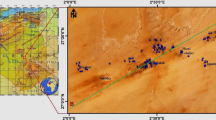Abstract
Turbid-water problem of reservoirs due to soil erosion causes a major issue in dam operation. This study presents a methodology to quantitatively analyze the occurrence possibility of turbid-water in four hydrologic basins (Sayeon, Degok, Gwangdong, and Imha Dam basins in S. Korea), quantifying the weighting value of turbid-water occurrence in reservoirs. To do this, the study conducted indoor tests, including laser-assisted particle size analysis, X-ray powder diffraction method analysis, and scanning electron microscope, to give the geologic characteristics such as the distribution of soil particle size, settlement time, landslide, and existing sediment yield. The study used RUSLE models to calculate sediment yield on the basis of soil maps, DEMs, and landcover maps as auxiliary data. This study classified factors for evaluating the possibility of turbid-water occurrence into geology, sediment yield, landslide and soil components, and these evaluation items’ weighting and score are presented using the analytic hierarchy process technique. The suggested method is promising in that it can analyze the risk factor of turbid-water occurrence in basins and that can provide a guideline to estimate the turbid-water occurrence of reservoir in dam construction.










Similar content being viewed by others
References
Aras H, Erdogmus S, Koc E (2004) Multi-criteria selection for a wind observation station location using analytic hierarchy process. Renew Energy 29:1383–1392
Bartsch KP (1998) Modelling soil loss to determine water loss risk at Camp Williams national guard base. Phd thesis, Utah State University, USA
Billota GS, Brazier RE (2008) Understanding the influence of suspended solids on water quality and aquatic biota. Water Res 47:2849–2861
Boyce R (1975) Sediment routing and sediment delivery ratio: in present and prospective technology for predicting sediment yields and sources. USDA ARS-S-40:61–65
Cesare GD, Boillat JL, Schleiss AJ (2006) Circulation in stratified lakes due to flood-induced turbidity currents. J Environ Eng 132(11):1508–1517
Chen C, Tang S, Pan Z, Zhan H, Larson M, Jonsson L (2007) Remotely sensed assessment of water quality levels in the Pearl river estuary, China. Mar Pollut Bull 54:1267–1272
Erickson AJ (1997) Aids for estimating soil erodibility—K value class and soil loss tolerance. US Department of Agriculture, Soil Conservation Services, Salt Lake City, Utah
Frentle M, Julien PY (1987) Computer modeling of soil erosion and sediment yield from large watershed. Int J Sediment Res 2:38–68
Gong P, Howarth P (1992) Frequency based contextual classification and gray-level vector reduction for landuse identification. Photogramm Eng Remote Sens 58(4):423–437
Herath G (2004) Incorporating community objectives in improved wetland management: the use of the analytic hierarchy process. J Environ Manag 70:263–273
Hill MJ, Braaten R, Veitch SM, Lees BG, Sharma S (2005) Multi-criteria decision analysis in spatial decision support: the ASSESS analytic hierarchy process and the role of quantitative methods and spatially explicit analysis. Environ Model Softw 20:955–976
Houghton JT, Jenkins GJ, Ephraums JJ (2001) Climate change 2001. Cambridge University Press, Cambridge
Jensen JR (1996) Introductory digital image processing. Prentice Hall Series in Geographic Information Science, pp 197–231. ISBN 0-13-205840-5
Kablan MM (2004) Decision support for energy conservation promotion: an analytic hierarchy process approach. Energy Policy 32:1151–1158
Krajnc D, Glavic P (2005a) A model for integrated assessment of sustainable development. Resour Conserv Recycl 43:189–208
Krajnc D, Glavic P (2005b) How to compare companies on relevant dimensions of sustainability. Ecol Econ 55:551–563
Mikhailov L, Tsvetinov P (2004) Evaluation of services using a fuzzy analytic hierarchy process. Appl Comput 5:23–33
Nearing MA (1997) A single continuous function for slope steepness influence on soil loss. Soil Sci Soc Am J 6(3):917–919
Olmanson LG, Bauer MB, Brezonik PL (2008) A 20-year landsat water quality census of Minnesota’s 10000 lakes. Remote Sens Environ 112:4085–4097
Pionke HB, Blanchard BJ (1975) The remote sensing of suspended sediment concentrations of small impoundments. Water Air Pollut 4:19–32
Randall P, Brown L, Deschaine L, Dimarzio J, Kaiser G, Vierow J (2004) Application of the analytic hierarchy process to compare alternatives for the long-term management of surplus mercury. J Environ Manag 71:35–43
Randolph K, Wilson J, Tedesco L, Li L, Pascual DL, Soyeux E (2008) Hyperspectral remote sensing of cyanobacteria in turbid productive water using optically active pigments, chlorophyll a and phycocyanin. Remote Sens Environ 112:4009–4019
Renard KG, Foster GR, Weesies GA, Porter PJ (1991) RUSLE: Revised Universal Soil Loss Equation. J Soil Water Conserv 46(1):30–33
Saaty TL (1980) The analytic hierarchy process. McGraw Hill, New York
Saaty RW (1987) The analytic hierarchy process—what it is and how it is used. Math Model 9:161–176
Sabins FF (1997) Remote sensing (principles and interpretation). Freeman Company, New York, pp 387–416. ISBN 0-7167-2442-1
Wischmeier WH (1971) A soil erodibility nomograph for farmland and construction sites. J Soil Water Conserv 26:189–193
Wischmeier WH, and Smith DD (1978) Predicting rainfall erosion losses—a guide to conservation planning. USDA-Agriculture Handbook No. 537. US Government Printing Office, Washington, DC
Zio E, Cantarella M, Cammi A (2003) The analytic hierarchy process as a systematic approach to the identification of important parameters for the reliability assessment of passive systems. Nucl Eng Des 226:311–336
Author information
Authors and Affiliations
Corresponding author
Rights and permissions
About this article
Cite this article
Lee, Gs., Lee, Kh. & Jeong, Gc. A strategy for quantifying turbid-water occurrence possibility based on geologic characteristics and soil erosion in hydrologic basins. Environ Earth Sci 59, 821–835 (2009). https://doi.org/10.1007/s12665-009-0078-5
Received:
Accepted:
Published:
Issue Date:
DOI: https://doi.org/10.1007/s12665-009-0078-5




